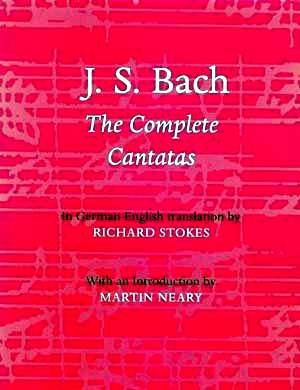Bach’s cantatas are settings of sacred texts (and secular
texts, for a handful of them) to music, in a structure that alternates
chorales, arias, and recitatives. While the music is eloquent enough
to speak for itself, Bach worked hard at marrying the tone of his music
to the texts. At times, individual instruments and melodies were chosen
to correspond to specific verses and words. While the cantatas can be
appreciated for the music they contain, a deeper exploration of their
texts can help listeners to understand the reasons behind many of Bach’s
musical choices.
This book contains a parallel translation of the texts
of all of Bach’s more than 200 extant cantatas. Each cantata is presented
with its BWV number (the standard Bach catalogue number), its title,
the author of the text, or the biblical reference, for chorales, and
the texts of each individual movement. These are not singing translations
- no attempt is made to rhyme the texts, which would be an aberration.
It is nearly impossible to translate poetry in rhyme and maintain the
same images and ideas, for the simple reason that the same words do
not rhyme in one language as in another.
When examining some of the translations provided in
liner notes of cantata recordings, the quality is variable. The groundbreaking
recordings by Gustav Leonhardt and Nicolas Harnoncourt contain the most
aberrant translations - the German word order is often retained, leading
to some ridiculous texts that make little sense in English. The texts
in Helmuth Rilling’s set are somewhat better, though they bathe in pseudo-archaism,
which renders them far too obscure. Philippe Herreweghe’s recordings
contain far better English translations, but they remain full of "thees"
and "thous", which are anything but modern.
For this is the main problem with translations of such
texts - translators tend to use archaic language, in English, because
the best-known Bible remains the King James’ Version. This text, to
our ears, sounds both archaic, yet biblical. The problem with this book
is that the translator did not stray sufficiently from this tradition,
and presents texts that are, at times, archaic and confusing. He tends
to retain the German word order in many cases where this is not at all
acceptable; cantata 134 contains a recitative (section 3), and the alto’s
first line in this section is, "The power of love is for me a banner/For
heroism, for strength amid the struggle…" I would have phrased
that as, "The power of love, for me, is a banner…" In cantata
166, he translates the title, "Whither goest thou?", which
is as archaic as one can get, yet translates the same words, later in
the text, as "whither do you go?" Personally, I would rather
not whither, and say, "Where are you going?" in both cases.
The entire translation has these hints of archaism
that could have been avoided. In order to make an "old" text
more accessible, translators tend to use contemporary language. As a
translator myself, I have been confronted with this issue; the best
solution is to use the language you are familiar with, rather than try
and adopt a style that dates.
In any case, this is an admirable project, and one
that is indeed useful for fans of Bach’s cantatas. Having all these
translations in one book is very practical, and, since they are better
than most of the translations found in liner notes, provide a textual
background to this essential sacred music.
Kirk McElhearn



